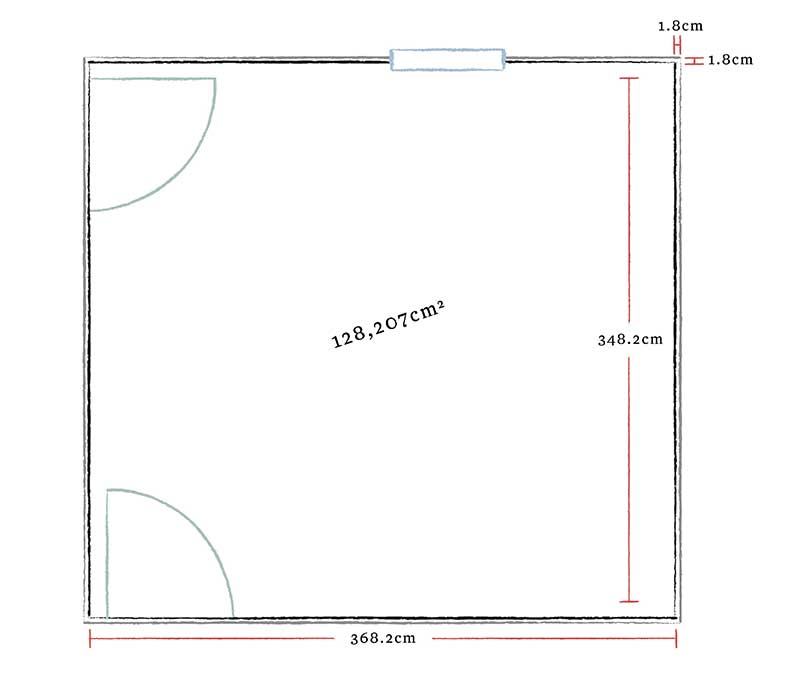How to measure your bedroom for a bed

Get the best Sleepyhead bed experience by making sure your new bed is the right size to fit comfortably in your bedroom and lifestyle. Whether you have a single bed, double bed or a king sized bed it is important to organise your bedroom space for an optimal sleeping environment. This is a simple step-by-step guide to show you how to correctly measure your bedroom for your new Sleepyhead bed. Once you’ve followed this guide, you’ll be confident in selecting the best size bed for your bedroom with plenty of surrounding living space to relax in. Our diagrams show a standard queen size bed within a standard master bedroom size.
1. Draw a floor plan of your bedroom
 Exactly how big is your bedroom? This is where you’ll need your measuring tape to measure the length of your bedroom’s inside walls, doors and windows. Once you have these you can draw a floor plan which sets out the size of your bedroom and where your doors and windows are positioned.
Exactly how big is your bedroom? This is where you’ll need your measuring tape to measure the length of your bedroom’s inside walls, doors and windows. Once you have these you can draw a floor plan which sets out the size of your bedroom and where your doors and windows are positioned.
2. Work out how much space you have
 Next, look at how much space you have in your bedroom. This will allow you to work out how much space you will have to move about in once your bed and bedroom furniture are in place.
You can work out the space by multiplying your bedroom’s length and width measurements together. This will give you the square metreage.
Tip: remember to consider any skirting-boards that make the space a little smaller, into your equation.
Next, look at how much space you have in your bedroom. This will allow you to work out how much space you will have to move about in once your bed and bedroom furniture are in place.
You can work out the space by multiplying your bedroom’s length and width measurements together. This will give you the square metreage.
Tip: remember to consider any skirting-boards that make the space a little smaller, into your equation.
3. Ensure your space is balanced
 Now you’ve got your space worked out, we recommend using the “1/3 ratio” rule – it’s commonly used by interior decorators to ensure a space is balanced. The idea is that your bed should take up a maximum of 1/3 of your bedroom space, with the walkway (including doorways) taking up 1/3, and your other furniture taking up 1/3. In our example bedroom, you could easily fit a King size bed.
Now you’ve got your space worked out, we recommend using the “1/3 ratio” rule – it’s commonly used by interior decorators to ensure a space is balanced. The idea is that your bed should take up a maximum of 1/3 of your bedroom space, with the walkway (including doorways) taking up 1/3, and your other furniture taking up 1/3. In our example bedroom, you could easily fit a King size bed.
4. Add your furniture
 Next, add other bedroom furniture into your floor plan, including their measurements. Be sure to measure the spans of any open doors, drawers and cupboards. Measure your bed base or frame along with your mattress (this can sometimes make your bed measurements bigger), and it’s a good idea to allow at least 70cm of space on either side of your bed.
Next, add other bedroom furniture into your floor plan, including their measurements. Be sure to measure the spans of any open doors, drawers and cupboards. Measure your bed base or frame along with your mattress (this can sometimes make your bed measurements bigger), and it’s a good idea to allow at least 70cm of space on either side of your bed.
5. Consider your wall space
 It’s also important to take a look at the height of the furniture and decorations in your room. Draw up a wall (elevation) view of your room, focusing on where your bed will go. This way you can ensure that your furniture isn’t too high (or too low for your room – consider the height of your hanging lights, picture frames, mirrors, lamps etc.
It’s also important to take a look at the height of the furniture and decorations in your room. Draw up a wall (elevation) view of your room, focusing on where your bed will go. This way you can ensure that your furniture isn’t too high (or too low for your room – consider the height of your hanging lights, picture frames, mirrors, lamps etc. 





